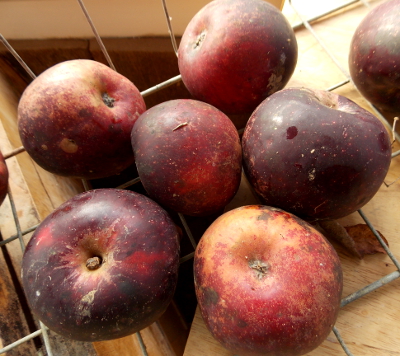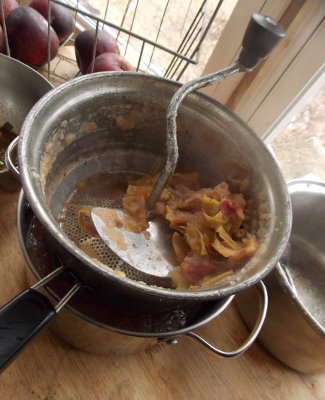
Storage apples
 If
you're a frugivore like me and prefer fresh fruit, trying out (and then
planting) storage apples that will go the distance makes a lot of
sense. To that end, we bought some Winesaps, Stayman Winesaps, and Arkansas Black apples last fall, put them in the fridge root cellar, and waited to see what happened.
If
you're a frugivore like me and prefer fresh fruit, trying out (and then
planting) storage apples that will go the distance makes a lot of
sense. To that end, we bought some Winesaps, Stayman Winesaps, and Arkansas Black apples last fall, put them in the fridge root cellar, and waited to see what happened.
The first thing I noticed
is that the old-fashioned Winesaps tasted so good, they didn't last out
the first month. That's not a comment on their lack of storage
capabilities, but on their excellent flavor! The Stayman Winesaps
were my next-favorite in flavor when we first got them, but those apples
started to go mealy inside partway into December, and I cooked up the
last ones into applesauce this week before they rotted.
 Arkansas
Blacks were a bit of a surprise. When we first bought them, the
apples tasted a bit insipid (but crisp). As they aged in the
fridge root cellar, though, the flavor changed, becoming more complex
and taking on a hint of banana. (I'd always wondered if the apple
variety Winter Banana really tastes like a banana, and now I'm guessing
it does.) Meanwhile, the Arkansas Black apples have yet to lose
any crispness, even under home storage conditions, so around the end of
December, Arkansas Black became my favored nibble over the Stayman
Winesaps.
Arkansas
Blacks were a bit of a surprise. When we first bought them, the
apples tasted a bit insipid (but crisp). As they aged in the
fridge root cellar, though, the flavor changed, becoming more complex
and taking on a hint of banana. (I'd always wondered if the apple
variety Winter Banana really tastes like a banana, and now I'm guessing
it does.) Meanwhile, the Arkansas Black apples have yet to lose
any crispness, even under home storage conditions, so around the end of
December, Arkansas Black became my favored nibble over the Stayman
Winesaps.
In case you're curious
about other apples that will last at least until the new year, the chart
below, excerpted from various sources, suggests some popular
choices. I haven't cross-referenced this against my list of disease-resistant apples,
though, so be sure to check there before putting in one of these
varieties and planning on it being a low-work addition to the orchard.
| Variety |
Ripens |
Keeps until |
| Arkansas Black |
Late October |
Spring |
| Ashmead's Kernel |
October |
March |
| Braeburn |
Mid October |
February |
| Cameo |
Late October |
Spring |
| Clearwater Gold |
Late October |
Spring |
| Enterprise |
Late September |
February |
| Freedom |
October |
January |
| Fuji |
Mid October |
Spring |
| Golden Delicious |
Late September |
February |
| Golden Russet |
Early October |
January |
| Gold Rush |
Mid October |
Spring |
| Grime's Golden |
Late September |
January |
| Honey Crisp |
Early September |
February |
| Hudson's Golden Gem |
Early October |
January |
| Ida Red |
Early October |
February |
| Jonalicious |
Early September |
March |
| Mammoth Black Twig |
October |
April |
| Melrose |
Early October |
February |
| Mollie's Delicious |
Late August |
January |
| Mutsu |
Early October |
February |
| Orin |
Late September |
January |
| Splendour |
Early October |
February |
| Spigold |
Late September |
January |
| Stayman Winesap |
Early October |
January |
| Stellar |
Early October |
March |
| Suncrisp |
Mid October |
January |
| Sundance |
September |
January |
| Virginia Gold |
Early October |
February |
| Winesap |
Mid October |
January to February (depending on variety) |
I'd be curious to hear
from others who have stocked up on apples in the fall and watched to see
which ones made it through the winter. Which varieties do you
find last best under home storage conditions?
Want more in-depth information? Browse through our books.
Or explore more posts by date or by subject.
About us: Anna Hess and Mark Hamilton spent over a decade living self-sufficiently in the mountains of Virginia before moving north to start over from scratch in the foothills of Ohio. They've experimented with permaculture, no-till gardening, trailersteading, home-based microbusinesses and much more, writing about their adventures in both blogs and books.
Want to be notified when new comments are posted on this page? Click on the RSS button after you add a comment to subscribe to the comment feed, or simply check the box beside "email replies to me" while writing your comment.

Hi Anna and Mark,
From what I can tell, how long produce keeps is more a function of its nutrient density than anything else. See for example, Jerry Burnetti's latest article on butternut squash in AcresUSA. See also tandjenterprises.com.
Both talk about their road towards high Brix produce. Jerry has a picture of two butternut next to each other. One was picked the year before and stored at 'room' temperature.
Tom says that nutrient dense produce doesn't rot. So I wonder if the data is more about soil health and minor trace minerals than variety?
I am still eating apples from last year. The Macs are best so far. They came from a tree with LOTS of bark mulch nearby. Mostly no bugs!
warm regards to you both, John